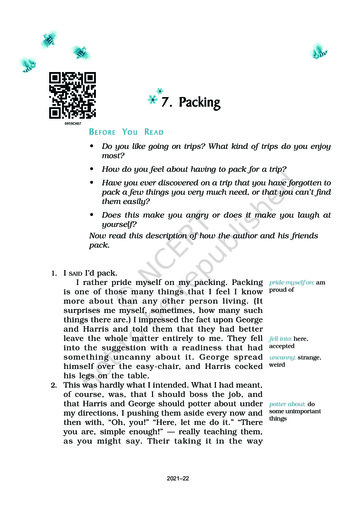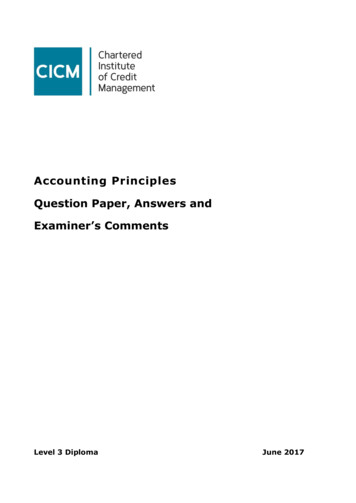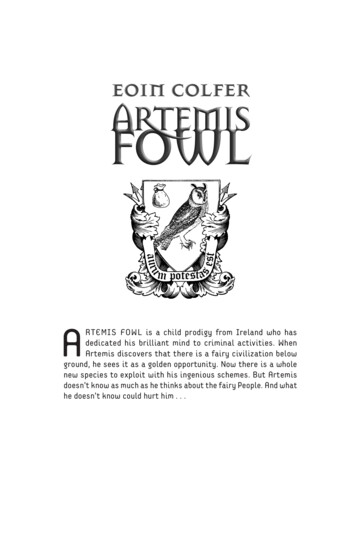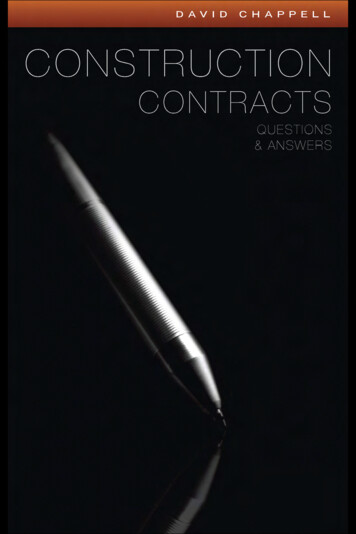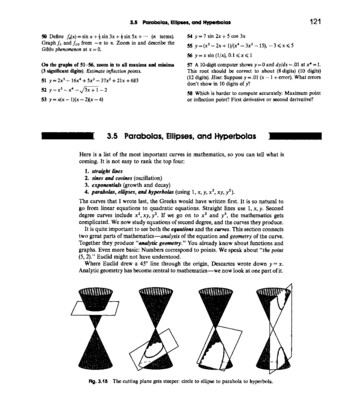
Transcription
3.5 Parabolas, Ellipses, and Hyperbolas(n terms).50 Define f,(x) sin x 4 sin 3x f sin 5x Graph f5 and f,, from - x to 71. Zoom in and describe theGibbs phenomenon at x 0.54 y 7 sin 2x 5 cos 3x55 y (x3-2x 1)/(x4-3x2-15),-3, x 556 y x sin (llx), 0.1 , x Q 1On the graphs of 51-56, zoom in to all maxima and minima(3 significant digits). Estimate inflection points. 51 y 2x5 - 16x4 5x3 - 37x2 21x52 y x 5 - 4 - J W - 253 y x(x - l)(x - 2)(x - 4) 68357 A 10-digit computer shows y 0 and dy/dx .O1 at x* 1.This root should be correct to about (8 digits) (10 digits)(12 digits). Hint: Suppose y .O1 (x - 1 error). What errorsdon't show in 10 digits of y?58 Which is harder to compute accurately: Maximum pointor inflection point? First derivative or second derivative?Here is a list of the most important curves in mathematics, so you can tell what iscoming. It is not easy to rank the top four:1. straight lines2. sines and cosines (oscillation)3. exponentials (growth and decay)4. parabolas, ellipses, and hyperbolas (using 1, x, y, x2, xy, y2).The curves that I wrote last, the Greeks would have written first. It is so natural togo from linear equations to quadratic equations. Straight lines use 1,x, y. Seconddegree curves include x2, xy, y2. If we go on to x3 and y3, the mathematics getscomplicated. We now study equations of second degree, and the curves they produce.It is quite important to see both the equations and the curves. This section connectstwo great parts of mathematics-analysis of the equation and geometry of the curve.Together they produce "analytic geometry." You already know about functions andgraphs. Even more basic: Numbers correspond to points. We speak about "the point(5,2)." Euclid might not have understood.Where Euclid drew a 45" line through the origin, Descartes wrote down y x.Analytic geometry has become central to mathematics-we now look at one part of it.Fig. 3.15 The cutting plane gets steeper: circle to ellipse to parabola to hyperbola.
3 Appllcatlonr of the DerhrathreCONIC SECTIONSThe parabola and ellipse and hyperbola have absolutely remarkable properties. TheGreeks discovered that all these curves come from slicing a cone by a plane. Thecurves are "conic sections." A level cut gives a circle, and a moderate angle producesan ellipse. A steep cut gives the two pieces of a hyperbola (Figure 3.15d). At theborderline, when the slicing angle matches the cone angle, the plane carves out aparabola. It has one branch like an ellipse, but it opens to infinity like a hyperbola.Throughout mathematics, parabolas are on the border between ellipses andhyperbolas.To repeat: We can slice through cones or we can look for equations. For a coneof light, we see an ellipse on the wall. (The wall cuts into the light cone.) For anequation AX Bxy Cy2 Dx Ey F 0, we will work to make it simpler. Thegraph will be centered and rescaled (and rotated if necessary), aiming for an equationlike y x2. Eccentricity and polar coordinates are left for Chapter 9.THE PARABOLA y m2 bx cYou knew this function long before calculus. The graph crosses the x axis wheny 0. The quadratic formula solves y 3x2 - 4x 1 0, and so does factoring into(x - 1)(3x - 1). The crossing points x 1 and x f come from algebra.The other important point is found by calculus. It is the minimum point, wheredyldx 6x - 4 0. The x coordinate is 8 f , halfway between the crossing points.This is the vertex V in Figure 3.16a-at the bottom of theThe height is ymin - i.parabola.A parabola has no asymptotes. The slope 6x - 4 doesn't approach a constant.To center the vertex Shift left by 3 and up by f . So introduce the new variablesand Y y f . hen x f and y - 3 correspond to X Y O-whichis the new vertex:y 3x2- 4x 1 becomes Y 3X 2.(1)x x- Check the algebra. Y 3X2 is the same as y f 3(x - 3)2. That simplifies to theoriginal equation y 3x2- 4x 1. The second graph shows the centered parabolaY 3X2, with the vertex moved to the origin.To zoom in on the vertex Rescale X and Y by the zoom factor a:Y 3 x 2 becomes y/a 3 ( / a ) .The final equation has x and y in boldface. With a 3 we find y x2-the graph ismagnified by 3. In two steps we have reached the model parabola opening upward.I directrix at y - 4Fig. 3.16 Parabola with minimum at V. Rays reflect to focus. Centered in (b), rescaled in (c).
3.5 Parabolas, Ellipses, and HyperbolasA parabola has another important point-the focus. Its distance from the vertexis called p. The special parabola y x2 has p 114, and other parabolas Y a x 2have p 1/4a. You magnify by a factor a to get y x2. The beautiful property of aparabola is that every ray coming straight down is reflected to the focus.Problem 2.3.25 located the focus F-here we mention two applications. A solarcollector and a TV dish are parabolic. They concentrate sun rays and TV signalsonto a point-a heat cell or a receiver collects them at the focus. The 1982 UMAPJournal explains how radar and sonar use the same idea. Car headlights turn theidea around, and send the light outward.Here is a classical fact about parabolas. From each point on the curve, the distanceto the focus equals the distance to the "directrix." The directrix is the line y - pbelow the vertex (so the vertex is halfway between focus and directrix). With p 4,the distance down from any (x, y) is y 4. Match that with the distance to the focusat (0,a)- this is the square root below. Out comes the special parabola y x2:y 4 -(square both sides)-y x2.(2)The exercises give practice with all the steps we have taken-center the parabola toY a x 2 , rescale it to y x2, locate the vertex and focus and directrix.Summary for other parabolas y ax2 bx c has its vertex where dy/dx is zero.Thus 2ax b 0 and x - b/2a. Shifting across to that point is "completing thesquare":(ax2 bx e equals a x :l)i C.Here C c - (b2/4a)is the height of the vertex. The centering transform X x (b/2a),Y y - C produces Y a x 2 . It moves the vertex to (0, 0), where it belongs.For the ellipse and hyperbola, our plan of attack is the same:1. Center the curve to remove any linear terms Dx and Ey.2. Locate each focus and discover the reflection property.3. Rotate to remove Bxy if the equation contains it.x2 y2ELLIPSES - - 1 (CIRCLES HAVE a b )a 2 b2This equation makes the ellipse symmetric about (0, 0)-the center. Changing x to-x or y to -y leaves the same equation. No extra centering or rotation is needed.The equation also shows that x2/a2 and y2/b2 cannot exceed one. (They add toone and can't be negative.) Therefore x2 a2,and x stays between - a and a. Similarlyy stays between b and - b. The ellipse is inside a rectangle.By solving for y we get a function (or two functions!) of x:The graphs are the top half ( ) and bottom half (-) of the ellipse. To draw the ellipse,plot them together. They meet when y 0, at x a on the far right of Figure 3.17and at x - a on the far left. The maximum y b and minimum y - b are at thetop and bottom of the ellipse, where we bump into the enclosing rectangle.A circle is a special case of an ellipse, when a b. The circle equation x2 y2 r2is the ellipse equation with a b r. This circle is centered at (0,O); other circles are
3 Applications of the Derivativecentered at x h, y k. The circle is determined by its radius r and its center (h, k):Equation of circle: (x - h)' (y - k)2 r2.(4)In words, the distance from (x, y) on the circle to (h, k) at the center is r. Theequation has linear terms - 2hx and - 2ky-they disappear when the center is (0,O).EXAMPLE 1Find the circle that has a diameter from (1,7) to (5, 7).Solution The center is halfway at (3,7). So r 2 and (x - 3)2 (y - 7)2 22.EXAMPLE2Find the center and radius of the circle x2 - 6x y2 - 14y - 54.Solution Complete x2 - 6x to the square (x - 3)2 by adding 9. Complete y2 - 14yto (y - 7)2 by adding 49. Adding 9 and 49 to both sides of the equation leaves(x - 3)2 (y - 7)2 4-the same circle as in Example 1. Quicker Solution Match the given equation with (4). Then h 3, k 7, and r 2:x2 - 6x y2 - 14y - 54 must agree with x2 - 2hx h2 y2 - 2ky k2 r2.The change to X x - h and Y y - k moves the center of the circle from (h, k)to (0,O). This is equally true for an ellipse:x2 y 2 1.- - a2 b2When we rescale by x Xja and y Ylb, we get the unit circle x2 y2 1.( - h ) (y-k)lThe ellipse - -- 1 becomesab2The unit circle has area n. The ellipse has area nab (proved later in the book). Thedistance around the circle is 2n. The distance around an ellipse does not rescale-ithas no simple formula.Fig. 3.17Uncentered circle. Centered ellipse y12 / 2 23 1 . The distance from center tofar right is also a 3. All rays from F 2 reflect to F , .Now we leave circles and concentrate on ellipses. They have two foci (pronouncedfo-sigh). For a parabola, the second focus is at infinity. For a circle, both foci are atthe center. The foci of an ellipse are on its longer axis (its major axis), one focus oneach side of the center: , i s a t x e J a - b andF2isatx -c.The right triangle in Figure 3.17 has sides a, b, c. From the top of the ellipse, thedistance to each focus is a. From the endpoint at x a, the distances to the foci area c and a - c. Adding (a c) (a - c) gives 2a. As you go around the ellipse, thedistance to F , plus the distance to F2 is constant (always 2a).
3.5 Parabolas, Ellipses, and Hyperbolas3H At all points on the ellipse, the sum of distances from the foci is2a. Thisis another equation for the ellipse:from F1 and F 2 to (X,y):(X-)2 y2 2 /(x2a.(5)To draw an ellipse, tie a string of length 2a to the foci. Keep the string taut and yourmoving pencil will create the ellipse. This description uses a and c-the other formuses a and b (remember b2 c 2 a2 ). Problem 24 asks you to simplify equation (5)until you reach x 2/a2 y 2/b 2 1.The "whispering gallery" of the United States Senate is an ellipse. If you stand atone focus and speak quietly, you can be heard at the other focus (and nowhere else).Your voice is reflected off the walls to the other focus-following the path of thestring. For a parabola the rays come in to the focus from infinity-where the secondfocus is.A hospital uses this reflection property to split up kidney stones. The patient sitsinside an ellipse with the kidney stone at one focus. At the other focus a lithotriptersends out hundreds of small shocks. You get a spinal anesthetic (I mean the patient)and the stones break into tiny pieces.The most important focus is the Sun. The ellipse is the orbit of the Earth. SeeSection 12.4 for a terrible printing mistake by the Royal Mint, on England's lastpound note. They put the Sun at the center.Question 1 Why do the whispers (and shock waves) arrive together at the secondfocus?Answer Whichever way they go, the distance is 2a. Exception: straight path is 2c.Question 2 Locate the ellipse with equation 4x 2 9y 2 36.Answer Divide by 36 to change the constant to 1. Now identify a and b:22- -941 so a and b- /.9-4 Foci at.Question 3 Shift the center of that ellipse across and down to x 1, y - 5.Answer Change x to x - 1. Change y to y 5. The equation becomes(x - 1)2/9 (y 5)2/4 1. In practice we start with this uncentered ellipse and go theother way to center it.HYPERBOLASy2a2X2- I1b2Notice the minus sign for a hyperbola. That makes all the difference. Unlike an ellipse,x and y can both be large. The curve goes out to infinity. It is still symmetric, sincex can change to - x and y to - y.The center is at (0, 0). Solving for y again yields two functions ( and -):a - 1gives or2y .(6)The hyperbola has two branches that never meet. The upper branch, with a plus sign,has y a. The vertex V1 is at x 0, y a-the lowest point on the branch. Muchfurther out, when x is large, the hyperbola climbs up beside its sloping asymptotes:x22if - 1000 then b21001. So-ais close tobor -b.
3 Applications of the Derivative7reach curvefixedtime apartFig. 3.18 The hyperbola iy2- &x2 1 has a 2, b 3, c -/,.F , differ by 2a 4.lightwavesreflectto F2The distances to F 1 andThe asymptotes are the lines yla x/b and yla - x/b. Their slopes are a/b and - a/b.You can't miss them in Figure 3.18.For a hyperbola, the foci are inside the two branches. Their distance from thecenter is still called c. But now c ,/ which,is larger than a and b. The vertexis a distance c - a from one focus and c a from the other. The diflerence (not thesum) is (c a) - (c - a) 2a.All points on the hyperbola have this property: The diflerence between distances tothe foci is constantly 2a. A ray coming in to one focus is reflected toward the other.The reflection is on the outside of the hyperbola, and the inside of the ellipse.Here is an application to navigation. Radio signals leave two fixed transmitters atthe same time. A ship receives the signals a millisecond apart. Where is the ship?Answer: It is on a hyperbola with foci at the transmitters. Radio signals travel186 miles in a millisecond, so 186 2a. This determines the curve. In Long RangeNavigation (LORAN) a third transmitter gives another hyperbola. Then the shipis located exactly.Question 4 How do hyperbolas differ from parabolas, far from the center?Answer Hyperbolas have asymptotes. Parabolas don't.The hyperbola has a natural rescaling. The appearance of x/b is a signal to changeto X . Similarly yla becomes Y. Then Y 1 at the vertex, and we have a standardhyperbola:y2/a2- x2/b2 1 becomesY 2 - X 2 1.A 90" turn gives X 2 - y 2 l-the hyperbola opens to the sides. A 45" turn produces2X Y 1. We show below how to recognize x2 x y y2 1 as an ellipse andx2 3xy y2 1 as a hyperbola. (They are not circles because of the xy term.) Whenthe xy coefficient increases past 2, x2 y2 no longer indicates an ellipse. Question 5 Locate the hyperbola with equation 9y2 - 4x2 36.Divide by 36. Then y2/4 - x2/9 1. Recognize a and b Answer&fi.Question 6 Locate the uncentered hyperbola 9y2 - 18y - 4x2 - 4x 28.Complete 9 - 18y to 9(y - 1)2 by adding 9. Complete 4x2 4x to4(x )2 by adding 4(3)2 1. The equation is rewritten as 9(y - - 4(x )2 28 9 - 1. This is the hyperbola in Question 5 - except its center is (- ,I).Answer
3.5Parabolas, Ellipses, and HyperbolasTo summarize: Find the center by completing squares. Then read off a and b. THE GENERAL EQUATION Ax2 Bxy Cy2 Dx Ey F 0This equation is of second degree, containing any and all of 1, x, y, x2, xy, y2.A plane is cutting through a cone. Is the curve a parabola or ellipse or hyperbola?Start with the most important case Ax2 Bxy Cy2 1.I The equation Ax2 Bxy cyZ 1 produces a hyperbola if B 4AC andan ellipse if B2 4AC. A parabola has B2 4AC.IITo recognize the curve, we remove Bxy by rotating the plane. This also changes Aand C-but the combination B - 4AC is not changed (proof omitted). An exampleis 2xy 1, with B 4. It rotates to y2 - x2 1, with - 4AC 4. That positivenumber 4 signals a hyperbola-since A - 1 and C 1 have opposite signs.Another example is x2 y2 1. It is a circle (a special ellipse). However we rotate,the equation stays the same. The combination B - 4AC 0 - 4 1 1 is negative, aspredicted for ellipses.To rotate by an angle a, change x and y to new variables x' and y':x X' cos a - y' sin ay x' sin a y' cos ax cos a y sin ay' - y sin a x cos a. and(7) Substituting for x and y changes AX Bxy c y 2 1 to A ' x ' B'xly' Cryf2 1.The formulas for A', B', C' are painful so I go to the key point:B' is zeroif the rotation angle a has tan2a B/(A - C).With B' 0, the curve is easily recognized from A ' x ' C'yr2 1. It is a hyperbola 4A1C' is positive. The original B - 4ACif A' and C' have opposite signs. Then B ' was also positive, because this special combination stays constant during rotation.After the xy term is gone, we deal with x and y-by centering. To find the center,complete squares as in Questions 3 and 6. For total perfection, rescale to one of themodel equations y x2 or x2 y2 1 or y2 - x2 1.The remaining question is about F 0. What is the graph of AX? Bxy c y 2 O?The ellipse-hyperbola-parabola have disappeared. But if the Greeks were right, thecone is still cut by a plane. The degenerate case F 0 occurs when the plane cutsright through the sharp point of the cone.A level cut hits only that one point (0,O). The equation shrinks to x2 y 2 0, acircle with radius zero. A steep cut gives two lines. The hyperbola becomes y2 -?. x2 0,leaving only its asymptotes y x. A cut at the exact angle of the cone gives onlyone line, as in x2 0. A single point, two lines, and one line are very extreme cases ofan ellipse, hyperbola, and parabola. All these "conic sections" come from planes and cones. The beauty of the geometry,which Archimedes saw, is matched by the importance of the equations. Galileo discovered that projectiles go along parabolas (Chapter 12). Kepler discovered that theEarth travels on an ellipse (also Chapter 12). Finally Einstein discovered that lighttravels on hyperbolas. That is in four dimensions, and not in Chapter 12.
3 Applications of the DerivativeequationPfocivertices1y ax2 bx cH -y2- - - x2Ia2 b2(0, a) and (0, - a)3.5- above vertex, alsoinfinity(0, c) and (0, - c): c ,/ EXERCISESRead-through questions The graph of y x2 2x 5 is a a . Its lowest point(the vertex) is (x, y) ( b ). Centering by X x 1 andY c moves the vertex to (0,O). The equation becomesY d . The focus of this centered parabola is e . Allto the focus.rays coming straight down are f The graph of x2 4 16 is an a . Dividing by hleaves x2/a2 y2/b2 1 with a i and b i . Thegraph lies in the rectangle whose sides are k . The area isnab I . The foci are at x c m . The sum ofdistances from the foci to a point on this ellipse is alwaysn . If we rescale to X x/4 and Y y/2 the equationbecomes 0 and the graph becomes a p . The graph of y2 - x2 9 is a q . Dividing by 9 leavesy2/a2- x2/b2 1 with a rand b s . On theupper branch y 3 t . The asymptotes are the lines.The foci are at y c v . The w of distances fromthe foci to a point on this hyperbola is x . All these curves are conic sections-the intersection of aYand a. A steep cutting angle yields a A . Atthe borderline angle we get a B . The general equation isAX C F 0. If D E 0 the center of the graph isat D . The equation Ax2 Bxy Cy2 1 gives an ellipsewhen E . The graph of 4x2 5xy 6y2 1 is a F . Problems 15-20 are about parabolas, 21-34 are about ellipses,35-41 are about hyperbolas.15 Find the parabola y ax2 hx c that goes through(0,O) and (1, 1) and (2, 12).16 y x2 - x has vertex atand Y (0, 0) set X . To move the vertex to. Then Y X2.17 (a) In equation (2) change to p. Square and simplify.(b) Locate the focus and directrix of Y 3x2. Whichpoints are a distance 1 from the directrix and focus?18 The parabola y 9 - x2 openswith vertex at. Centering by Y y - 9 yields Y -x2.19 Find equations for all parabolas which(a) open to the right with vertex at (0,O)(b) open upwards with focus at (0,O)(c) open downwards and go through (0,O) and (1,O).20 A projectile is at x t, y t - t2 at time t. Find dxldt anddyldt at the start, the maximum height, and an xy equationfor the path.1 The vertex of y ax2 bx c is at x y '- b/2a. What isspecial about this x? Show that it gives y c - (b2/4a).21 Find the equation of the ellipse with extreme points at( 2,O) and (0, 1). Then shift the center to (1, 1) and find thenew equation.2 The parabola y 3x2 - 12x has xmin . At thisminimum, 3x2 isas large as 12x. Introducing.X x - 2 and Y y 12 centers the equation to22 On the ellipse x2/a2 y2/b2 1, solve for y whenx c This height above the focus will be valuablein proving Kepler's third law.Draw the curves 3-14 by hand or calculator or computer.Locate the vertices and foci. /,.23 Find equations for the ellipses with these properties:(a) through (5, 0) with foci at ( 4, 0)(b) with sum of distances to (1, 1) and (5, 1) equal to 12(c) with both foci at (0, 0) and sum of distances 2a 10.24 Move a square root to the right side of equation (5) andsquare both sides. Then isolate the remaining square root andsquare again. Simplify to reach the equation of an ellipse.
1293.5 Parabolas, Ellipses, a n d Hyperbolas25 Decide between circle-ellipse-parabola-hyperbola, basedon the XY equation with X x - 1 and Y y 3.(a) x2 - 2x Y2 6y 6(b) - 2 x - - 6 6(c) - 2 x 212y 6 (d) x2 - 2x - y 6.33 Rotate the axes of x2 xy y2 1 by using equation (7)with sin a cos a l / f i . The x'y' equation should show anellipse.34 What are a, b, c for the Earth's orbit around the sun?35 Find an equation for the hyperbola with(a) vertices (0, & I), foci (0, & 2)(b) vertices (0, & 3), asymptotes y 2x26 A tilted cylinder has equation (x - 2y - 2 ) (c) (2, 3) on the curve, asymptotes y x(y - 2x - 2 )1. Show that the water surface at z 0 is anellipse. What is its equation and what is B - 4AC?36 Find the slope of y 2 - x 2 1 at (xO,yo). Show thatyy, - xx, 1 goes through this point with the right slope (it27 (4, 915) is above the focus on the ellipse x2/25 y2/9 1.has to be the tangent line).Find dyldx at that point and the equation of the tangent line.37 If the distances from (x, y) to (8, 0) and (-8, 0) differ by28 (a) Check that the line xxo yy, r2 is tangent to the10, what hyperbola contains (x, y)?circle x2 Y2 r2 at (x,, yo).38 If a cannon was heard by Napoleon and one second later(b) For the ellipse x2/a2 y2/b2 1 show that the tangentby the Duke of Wellington, the cannon was somewhere on aequation is xxo/a2 yyo/b2 1. (Check the slope.)with foci at. and 2x2 12x39 y2 - 4y is part of (y - 2)2 . Therefore y2 - 4y is part of 2(x 3)2 2x2 - 12x 0 gives the hyperbola (y - 2)2 - 2(x 3)2 . Its center isand it opens to the. 40 Following Problem 39 turn y2 2y x2 lox intoy 2 x2 C with X, Y, and C equal to.'29 The slope of the normal line in Figure A is s - l/(slopeof tangent) . The slope of the line from F 2 isS . By the reflection property,Test your numbers s and S against this equation.30 Figure B proves the reflecting property of an ellipse.R is the mirror image of F , in the tangent line; Q is any otherpoint on the line. Deduce steps 2, 3, 4 from 1, 2, 3:1.2.3.4.P F , PF2 QF1 QF2 (left side 2a, Q is outside)PR P F 2 QR QF2P is on the straight line from F 2 to Ra ,8: the reflecting property is proved.31 The ellipse (x - 3)2!4 (y - 1)2/4 1 is really awith center atand radius. Choose X andY to produce X 2 Y2 1.32 Compute the area of a square that just fits inside theellipse x2/a2 y2/b2 1.41 Draw the hyperbola x2 - 4y2 1 and find its foci andasymptotes.Problems 42-46 are about second-degree curves (conics).42 For which A, C, F does AX tion (empty graph)? cy2 F 0 have no solu-43 Show that x2 2xy y2 2x 2y 1 0 is the equation(squared) of a single line.44 Given anycurve AX . F 0points in the plane, a second-degreegoes through those points.45 (a) When the plane z ax by c meets the conez2 x2 y2, eliminate z by squaring the plane equation.Rewrite in the form Ax2 Bxy Cy2 Dx Ey F 0.(b) Compute B2 - 4AC in terms of a and b.(c) Show that the plane meets the cone in an ellipse ifa2 b2 1 and a hyperbola if a 2 b2 1 (steeper).46 The roots of ax2 bx c 0 also involve the special combination b2 - 4ac. This quadratic equation has two real rootsifand no real roots if. The roots cometogether when b2 4ac, which is the borderline case like aparabola.
1303 Applications of the Derivative3.6 Iterations X n 1 F ( x n )Iteration means repeating the same function. Suppose the function is F(x) cos x.Choose any starting value, say x, 1. Take its cosine: x, cos x, .54. Then takethe cosine of x, . That produces x2 cos .54 .86. The iteration is x, cos x,. Iam in radian mode on a calculator, pressing "cos" each time. The early numbers arenot important, what is important is the output after 12 or 30 or 100 steps:,., x29 .7391, 3 , .7391.The goal is to explain why the x's approach x* .739085 . Every starting valueEXAMPLE 1 x12 .75, x13 .73, x14 .74,x, leads to this same number x*. What is special about .7391?Note on iterations Do x1 cos x, and x2 cos x, mean that x, cos2x,? Absolutely not! Iteration creates a new and different function cos (cos x). It uses the cosbutton, not the squaring button. The third step creates F(F(F(x))).As soon as youcan, iterate with x, , 4 cos x,. What limit do the x's approach? Is it 3(.7931)?Let me slow down to understand these questions. The central idea is expressed bythe equation x, , F(x,). Substituting xo into F gives x,. This output x, is the inputthat leads to x,. In its turn, x2 is the input and out comes x, F(x2).This is iteration,and it produces the sequence x,, x,, x2, .The x's may approach a limit x*, depending on the function F. Sometimes x* alsodepends on the starting value x,. Sometimes there is no limit. Look at a secondexample, which does not need a calculator.,EXAMPLE 2 x, F(x,) i x , 4. Starting from x, 0 the sequence is2 . 6 4 7 9 x 4 12 . 7 4 7 L2, .x, 4*0 4 4, x2 i*4 4 6, x3 LThose numbers 0, 4, 6, 7, 73, . . . seem to be approaching x* 8. A computer wouldconvince us. So will mathematics, when we see what is special about 8:When the x's approach x*, the limit of x, , ix, 4is X* I,x * 4. This limiting equation yields x* 8. 8 is the "steady state" where input equals output: 8 F(8). It is thefixedpoint.If we start at x, 8, the sequence is 8, 8, 8, . . When we start at x, 12, thesequence goes back toward 8:Equation for limit: If the iterations x, , F(x,) converge to x*, then x* F(x*).To repeat: 8 is special because it equals 4 8 4. The number .7391. . is special becauseit equals cos .7391. . The graphs of y x and y F(x) intersect at x*. To explain whythe x's converge (or why they don't) is the job of calculus.EXAMPLE 3 x n , xi has two fixed points: 0 0' and 1 12. Here F(x) x2.a, A,Starting from x, 3 the sequence&,. . . goes quickly to x* 0. The onlyapproaches to x* 1 are from x, 1 (of course) and from x, - 1. Starting fromx, 2 we get 4, 16, 256, . . . and the sequence diverges to m.Each limit x* has a "basin of attraction." The basin contains all starting points x,that lead to x*. For Examples 1 and 2, every x, led to .7391 and 8. The basins were
3.6 Iterations x,,,131 F(xJthe whole line (that is still to be proved). Example 3 had three basins-the interval-1 x, 1, the two points xo 1, and all the rest. The outer basin Ixo( 1 ledto co. I challenge you to find the limits and the basins of attraction (by calculator)for F(x) x - tan x.In Example 3, x* 0 is attracting. Points near x* move toward x*. The fixed pointx* 1 is repelling. Points near 1 move away. We now find the rule that decideswhether x* is attracting or repelling. The key is the slope dF/dx at x*. 3J Start from any x, near a fixed point x* F(x*):x* is attracting if IdF/dxf is below 1 at x*x* is repelling ifIdFldxl is above 1 at x*.First I will give a calculus proof. Then comes a picture of convergence, by "cobwebs."Both methods throw light on this crucial test for attraction: IdF/dxl 1.First proof: Subtract x* F(x*) from x,,, F(x,). The difference x,,, - x* isthe same as F(x,) - F(x*). This is AF. The basic idea of calculus is that AF is closeto F'Ax:x, - x* F(x,) - F(x*) z F1(x*)(xn- x*).(1),The "error" x, - x* is multiplied by the slope dF/dx. The next error x, - x* issmaller or larger, based on I F'I 1 or I F'I 1 at x*. Every step multiplies approximately by F1(x*).Its size controls the speed of convergence.In Example 1, F(x) is cos x and F1(x) is -sin x. There is attraction to .7391because lsin x* I 1. In Example 2, F is f x 4 and F' is i. There is attraction to 8.In Example 3, F is x2 and F' is 2x. There is superattraction to x* 0 (where F' 0).There is repulsion from x* 1 (where F' 2).I admit one major difficulty. The approximation in equation (1) only holds nearx*. If x, is far away, does the sequence still approach x*? When there are severalattracting points, which x* do we reach? This section starts with good iterations,which solve the equation x* F(x*) or f(x) 0. At the end we discover Newton'smethod. The next section produces crazy but wonderful iterations, not convergingand not blowing up. They lead to "fractals" and "Cantor sets" and "chaos."The mathematics of iterations is not finished. It may never be finished, but we areconverging on the answers. Please choose a function and join in.THE GRAPH OF AN ITERATION: COBWEBS,The iteration x,, F(x,) involves two graphs at the same time. One is the graphof y F(x). The other is the graph of y x (the 45" line). The iteration jumps backand forth between these graphs. It is a very convenient way to see the whole process.Example 1 was x,,, cos x,. Figure 3.19 shows the graph of cos x and the "cobweb." Starting at (x,, x,) on the 45" line, the rule is based on x, F(x,):From (x,, x,) go up or down to (x,, x,) on the curve.From (x,, x,) go across to (x,, x,) on the 45" line.These steps are repeated forever. From x, go up to the curve at F(x,). That heightis x, . Now cross to the 45" line at (x,, x,). The iterations are aiming for (x*, x*) (.7391, .7391). This is the crossing point of the two graphs y F(x) and y x.
3 Applicafions of the DerivativeFig. 3-49 Cobwebs go from (xo,xo)to (xo,xl) to ( x l ,xl)-lineto curve to line.Example 2 was xn , f xn 4. Both graphs are straight lines. The cobweb i
A circle is a special case of an ellipse, when a b. The circle equation x2 y2 r2 is the ellipse equation with a b r. This circle is centered at (0,O); other circles are . 3 Applications of the Derivative centered at x h, y k. The circle

